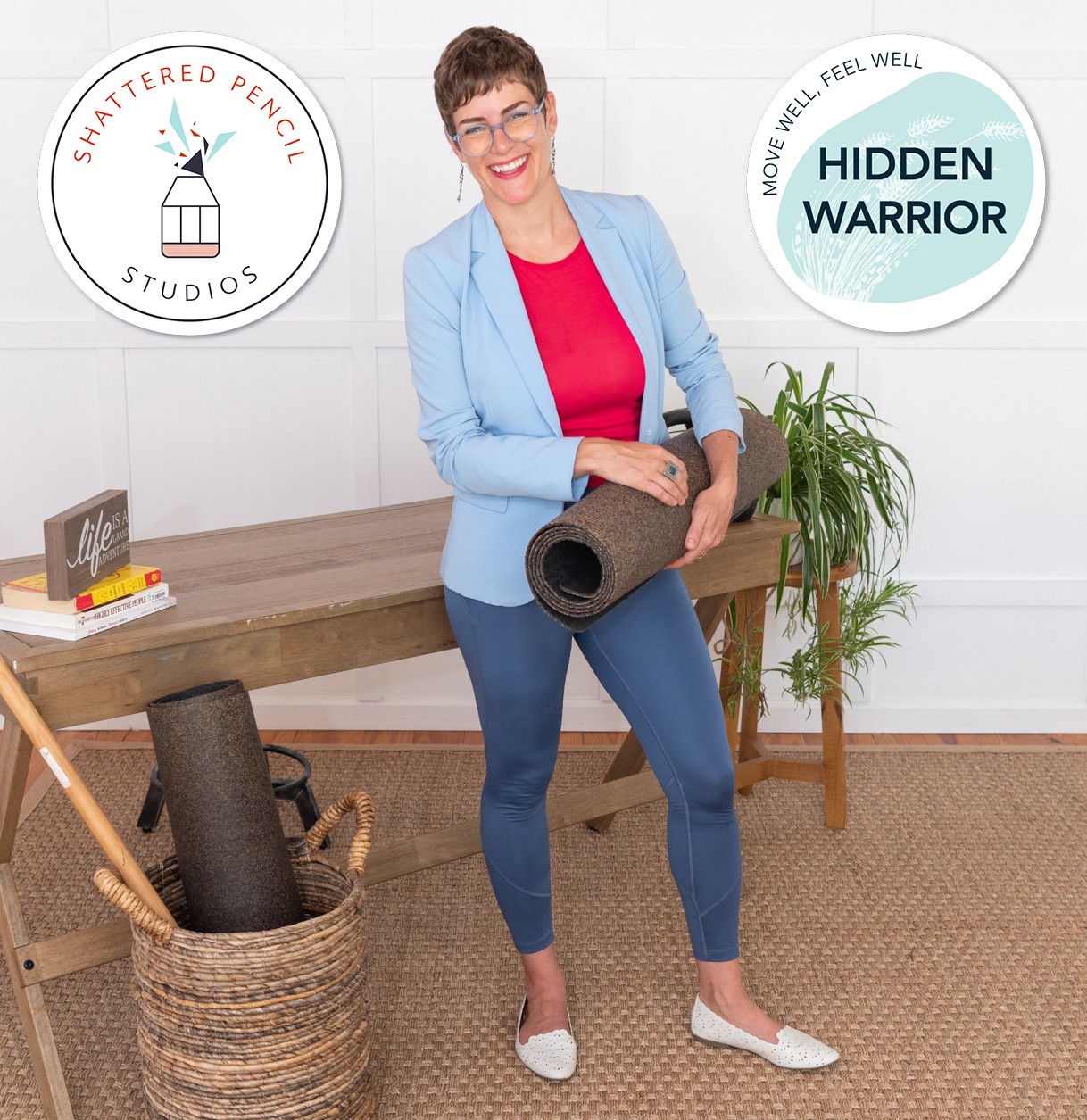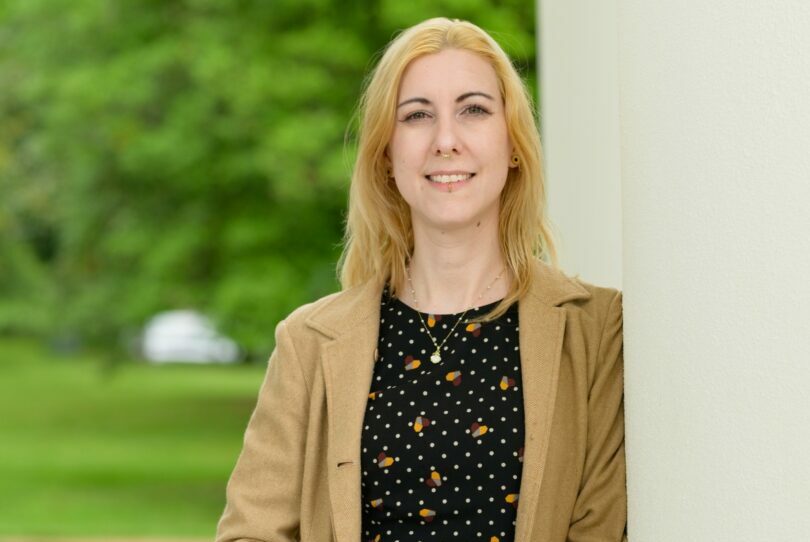We caught up with the brilliant and insightful Rosie Kosinski a few weeks ago and have shared our conversation below.
How did you overcome imposter syndrome?
Settling in at my laptop to begin this feature, I wasn’t sure what question to answer from the topics provided.
So I asked my husband to pick the question.
He selected “How did you overcome imposter syndrome” in two seconds, after skimming through the list.
Raising an eyebrow at him, I said, “but I haven’t overcome it, so what would I write? Wouldn’t it be a lie?” (classic imposter thoughts!)
He said: “In writing about it, you’ll figure it out.”
(Other imposter thought during this: “Am I worthy of being this thoughtful man’s wife?”)
I felt like a fraud writing about overcoming imposter syndrome.
And yet, here I am, doing it anyway. I am hopeful one of these words will be ones you needed to read today.
Overcoming anything (insecurities, ice cream cravings, and such) is not linear, not marked by a destination. It is swimming with beach waves. Sometimes they get you. Sometimes you dive head first into them, hop over them, or take a break on the shore.
Before I delve further, I am going to coin a term I learned from self-doubt expert and Psychologist Kevin Cokley: Imposter Phenomenon (IP) – that moment when you feel like someone will find you out, because surely you are a fraud. He thinks imposter syndrome is too clinical; I think it sounds like a chronic diagnosis.
For me, IP has the lifecycle of a particularly prickly emotion: something triggers it, I am affected by it, and I either have the awareness to challenge it and let it go (yay), or I adopt it with a false faith (gah).
I have experienced IP in every. single. Itty. bitty. area of my life. And I know I am not unique in this. I recently learned that despite popular belief, IP does not plague some demographics more than others. However, some groups of people are more likely to let it impact their performance. Men and women, for example, exhibit the same amount of self-doubt at school, yet women let their grades suffer more due to fully committing to the false truth of IP.
I have good news. Since IP is not a syndrome we have to be resigned to, there are practices anyone can adopt in order to overcome the feeling and its effects. Here are 3 that work well for me:
-
- Truth-Seeking: When I am in a room with professionals with more accolades, experience, and with seemingly more confidence than I have, my IP blows up yelling in my brain: “You don’t belong here! They will find you out soon enough!”. I take a moment and settle into the question: “Is this true?” – IP’s accusations cower in the face of the truth. Dr. Cokley likened IP to conspiracy theories – evidence is of no use. In fact, even contrary evidence will have you digging your heels into your sense of self-doubt. Instead, I find just very bluntly asking myself, “Is this true?” to help my mind reject the negative and unhelpful feedback leading to IP. When in serious doubt, just answer out loud to yourself: “No. I belong here.”
- Empathy: When I am drowning in my head’s self-sabotaging IP thoughts, I take a step away from the internal mirror, and think about someone I admire – someone I see as belonging in their space, whether that is professional, social, or familial. And I think about the times they have shared their insecurities and sense of fraudulence. I would emphatically reassure them of their rightful place, staggered by their lack of confidence. I can turn that reassurance right back at myself, get back to that internal mirror, and adopt this kinder approach.
- Self-Compassion: The critical voice in our brains is often told to be quiet. Yet it serves to protect us when appropriate, and it gets louder when told to shut up. Since the self-critical voice fuels self-doubt, I find it most helpful to practice this simple, effective and grounding self-compassion routine:
- Approach yourself mentally as you would a dear friend or loved one
- Place your hand on your own heart or your shoulder. This simultaneously settles you into the moment, and induces a feeling of being comforted and reassured
- With your hand placed, say, “Thank you for looking out for me. But I’m alright – I’m human, and I strive for improvement, and it’s ok that I’m not perfect”
- Make a self-compassionate commitment. Tell yourself something you need to hear for that specific moment, again thinking of what you would say to a dear friend. If you failed a test, it may be something like: “Kudos for taking the test and doing your best! Let’s look into more effective studying methods and see what material we need to improve on, and focus on that. You’ve got this!”
The most important mindset for me is rejecting the resignation that can come with experiencing the imposter phenomenon, or any sense of self-doubt and lack of belonging. I choose to challenge the thought each time it arises, rather than seeing myself as plagued by it continually. This is a journey – there will be potholes along the way! Don’t keep digging into the hole, step out of it and carry on, because you belong on this road.
Please tell our readers about what you do, what you feel is most exciting or special about it, as well as anything else you’d like folks to know about your brand/art/etc. If relevant, please also tell our readers about anything new (events, product/service launches, expansion, etc)
I hope the following will encourage anyone who can’t pick a “career,” or like they can’t stay in one lane, or they don’t have a distinct voice. Spoiler alert: this may be your greatest talent.
When I was studying at Davidson College, I was living that liberal arts experience to the max. I was fascinated by every subject (except history – but I blame that on how it’s taught). I loved botany, philosophy, psychology, language, the entire lot!
When I finally settled into studying Fine Art and English, professors from both departments had the same frustration with me. They told me I needed to narrow down my style and subject matter, and get focused.
Every time I explored one medium or approach, I would delight in it and then move on to another one. I was driven by curiosity. In the academic world, they misdiagnose this as lacking vision and purpose.
Being a dedicated student, I felt like a failure.
Fast-forward a decade, I could finally look back and celebrate this penchant for variety. At first, this quality did not pair well with corporate jobs, nor a clear career path.
But once I became a business owner, I found the space to flourish. I learned to be selective while embracing a diverse portfolio. Now, I can truly say I love every day, project, and client.
The very thing that exasperated my professors allows me to serve people and projects from vastly different contexts with equal enthusiasm and integrity.
I describe myself as a Creative Director & Entrepreneur due to my dual business roles. I run Shattered Pencil Studios, a Brand & Marketing boutique. We help businesses gain clarity and thoughtfully execute their vision. This can look like a whole brand identity, a single logo, a website design, or digital marketing. Or consulting to figure out what they need.
I also help run Hidden Warrior, which helps people and companies cultivate physical and mental wellbeing, at home or in the boardroom.
Currently, we are most excited about the accessible programs we offer through Hidden Warrior. For those who have lost trust in their body, feel chronic pain, or just want to start moving again, we have an 8-Week Body Reset course. This is made up of 15-20 minute self-paced videos that easily build awareness, strength, and mobility for anyone who can get out of bed (and who wants to feel better doing so.)
We also offer customized programs and workshops for groups and individuals – including hard-working corporate teams, equestrian groups, golf enthusiasts, and people exiting physical therapy and want to stay active without hurting themselves.
While I am in charge of running the show, the deep knowledge for getting people out of pain is Grant Clark, an expert in physical movement and wellbeing. He borrows from multiple modalities to ensure the most important feature for you and your body: results.
In all my roles, I thrive on listening to people’s stories, and pairing them with creative solutions that leave them with a sense of direction, relief, and excitement for refreshing results.
Looking back, what do you think were the three qualities, skills, or areas of knowledge that were most impactful in your journey? What advice do you have for folks who are early in their journey in terms of how they can best develop or improve on these?Three areas of practice that have been of the greatest impact on my journey (in business, personal relationships, and overall wellbeing), include:
Focusing on Possibilities
-
-
Concept: The basic premise is distinguishing the difference between a “result” (something you cannot control) and a “possibility” (a state of being or an outlook you actively adopt). For example: I want to have a successful business. I cannot control the outcome of my efforts, the market, people’s reactions etc. So my possibility is to BE a leader, to BE passionate, to BE reliable, honest and have integrity. In being these things and committing to the actions that back them up, I am writing my story and taking responsibility for my business, no matter the results. In this way, possibilities are more inspiring than goals, because you can achieve them right. this. second.- How to practice: Start small if this is new.
- You are just starting your business and you need to start networking. Whether you are procrastinating, over-stretching yourself with commitments, or you don’t feel you’re gaining traction in conversation, it’s time for a possibility. Instead of going in with a goal to sell or meet certain people, shift your mindset by developing your own possibility, which starts with “I am” or simply a state of being.
- For example: “I am a leader,” “listening,” “patience,” “I am joyful,” or “being at ease”
- Communicate this to others and tell them how you will achieve this. Tell your friends and colleagues – “hey! Tonight I am going to this event. As a leader and a listener, I am going to ask questions and learn from others. I will also be clear about what I do and its value only if they ask. I will be a positive force in the room and bring positive words to every conversation.”
- Observe: Just watch what shifts when you commit to the possibility, rather than trying to force an outcome of some sort. Notice the buoyant feeling that comes with freeing yourself from the pressure of results.
- You are just starting your business and you need to start networking. Whether you are procrastinating, over-stretching yourself with commitments, or you don’t feel you’re gaining traction in conversation, it’s time for a possibility. Instead of going in with a goal to sell or meet certain people, shift your mindset by developing your own possibility, which starts with “I am” or simply a state of being.
-
- Relying On Others
-
-
- Concept: This one is a bit more straightforward as a concept, although very difficult for many to accept! We are not meant to go through life shouldering everything alone – not the challenges, not the neutral moments, and not the joys. Even if it seems to be against your nature, resist the individualistic culture of “I can do it all on my own.” It’s exhausting, and you won’t do it well, and it won’t be nearly as fun or comforting.
- How to practice: For the majority of you that don’t want to bother anyone, here are some things you can practice:
- Praise report: Send a message to a friend, colleague or loved one saying “Thought you’d appreciate this random thing that made me smile.” Then share something from your day that you’re grateful for. This builds goodwill, trust, and bonding.
- Mini vent: Share something you’re struggling with, no matter how small, to a friend or colleague. “So-and-so hasn’t texted me back, and it’s driving me nuts. Just sharing.” – they’ll get it, and hey, maybe they’ll be relieved they’re not the only ones with that pet peeve.
- Prayer report: Share a bigger challenge with someone you trust, letting them know you aren’t looking for a solution right now, you just want some positive thoughts or prayers on “this rough spot I’m grappling with.” – Believe it or not, people who love you, love you sharing.
- Ask for advice: People freakin’ love giving their opinions. This one may be more fun for them than for you, in fact. No matter how small, “where can I find a freelancer?” or big, “I’m starting a business, where do I begin?!” – getting advice from people you trust leaves you with wisdom and validation, and them with a sense of satisfaction.
- Ask for help & delegate: The hardest, for sure, which is why you can build up to this one with the previous practices. Start with something non-urgent and that could be collaborative. Perhaps it’s “Hey, can you send me the template you use for your proposals?” or “Could you look over my new website and let me know what you think?”
- Receive: Say yes. When someone offers something, practice saying, “yes, thank you.” Tough one, isn’t it?
-
- Getting Out (Of My Head or Out the Door)
- Concept
-
-
- One of the first logos I struggled with is now one of my favourites (the one for Hidden Warrior (http://hidden-warrior.com/). I had no idea where to begin, because Grant, the owner, didn’t want something too simple and clean like other Yoga studios, nor too cliché or narrow. So I went for a walk, put on a podcast, and cast the whole project out of my head. While listening to the details of some gruesome true crime, I walked past a beautiful grassy plant blowing in the wind – at once anchored in the ground, yet flexible enough to dance in the movement of the airflow. Boom, that was the logo. Instead of staring at my computer for hours and getting nowhere, I got out and was more open to inspiration.
- How to practice: This one is dead simple. Get out. Out of your chair, into another room, out of the building. Start a different conversation. Listen to a different song. Feel a different texture. And most importantly: don’t put pressure on the moment to offer inspiration or answers. You may not be ready for them. So stay present and be open to any kind of learning. It could be profound, or could be that your colleague has 3 rescue cats.
-
What book has played an important role in your development and what were a few of the most valuable or impactful nuggets of wisdom?
“Never Split the Difference” by former FBI hostage negotiator Chris Voss. This book eradicated strife and power struggle from any business exchange and personal conflicts, by giving me straightforward guidelines for participating in life’s many negotiations. Here are the 5 top nuggets of wisdom that I found particularly valuable:
- “The most dangerous negotiation is the one you don’t know you’re in.” By recognizing the negotiation process, I could take proactive steps to lead any conversation to its most positive outcome.
- “No deal is better than a bad deal.” This beauty gave me the courage to say no to say many bad deals, and remain selective in my work. It is the mindset that has allowed me to truthfully say: I love every project and client.
- “Emotions are not the obstacles to a successful negotiation; they are the means.” This perspective challenges the conventional belief that emotions hinder negotiation. Instead, I can use emotions and empathy to develop connections and understanding that leads to win-win outcomes.
- “Negotiation is not an act of battle; it’s a process of discovery.” This gave me an appreciation for the collaborative nature of negotiation. Instead of approaching it as a confrontational exchange, viewing it as an opportunity to uncover information and find mutually beneficial solutions has been freeing.
- “Seek to understand before seeking to be understood.” This piece of humble wisdom is the foundation for active listening, which I continue to work on. By genuinely understanding the other party’s perspective, needs, and concerns, I can better provide solutions that benefit everyone involved.
Contact Info:
- Website: http://shatteredpencil.com/
- Instagram: https://www.instagram.com/shatteredpencilstudios/
- Facebook: https://www.facebook.com/love.at.first.sketch
- Linkedin: https://linkedin.com/in/rosie.kosinski






Image Credits
Charissa H. Yong Photography and Yasmeen Anderson Photography




